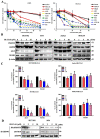Inhibition of PRMT5/MEP50 Arginine Methyltransferase Activity Causes Cancer Vulnerability in NDRG2low Adult T-Cell Leukemia/Lymphoma
- PMID: 38474089
- PMCID: PMC10932150
- DOI: 10.3390/ijms25052842
Inhibition of PRMT5/MEP50 Arginine Methyltransferase Activity Causes Cancer Vulnerability in NDRG2low Adult T-Cell Leukemia/Lymphoma
Abstract
N-myc downstream-regulated gene 2 (NDRG2), which is a tumour suppressor, is frequently lost in many types of tumours, including adult T-cell leukaemia/lymphoma (ATL). The downregulation of NDRG2 expression is involved in tumour progression through the aberrant phosphorylation of several important signalling molecules. We observed that the downregulation of NDRG2 induced the translocation of protein arginine methyltransferase 5 (PRMT5) from the nucleus to the cytoplasm via the increased phosphorylation of PRMT5 at Serine 335. In NDRG2low ATL, cytoplasmic PRMT5 enhanced HSP90A chaperone activity via arginine methylation, leading to tumour progression and the maintenance of oncogenic client proteins. Therefore, we examined whether the inhibition of PRMT5 activity is a drug target in NDRG2low tumours. The knockdown of PRMT5 and binding partner methylsome protein 50 (MEP50) expression significantly demonstrated the suppression of cell proliferation via the degradation of AKT and NEMO in NDRG2low ATL cells, whereas NDRG2-expressing cells did not impair the stability of client proteins. We suggest that the relationship between PRMT5/MEP50 and the downregulation of NDRG2 may exhibit a novel vulnerability and a therapeutic target. Treatment with the PRMT5-specific inhibitors CMP5 and HLCL61 was more sensitive in NDRG2low cancer cells than in NDRG2-expressing cells via the inhibition of HSP90 arginine methylation, along with the degradation of client proteins. Thus, interference with PRMT5 activity has become a feasible and effective strategy for promoting cancer vulnerability in NDRG2low ATL.
Keywords: ATL; MEP50; NDRG2; PRMT5; cancer vulnerability.
Conflict of interest statement
T.M. has financial interests in Denka Co., Ltd. T.I., A.S., S.N., H.I., K.S. and K.M. declare no competing interests in this article.
Figures








Similar articles
-
Novel PRMT5-mediated arginine methylations of HSP90A are essential for maintenance of HSP90A function in NDRG2low ATL and various cancer cells.Biochim Biophys Acta Mol Cell Res. 2020 Feb;1867(2):118615. doi: 10.1016/j.bbamcr.2019.118615. Epub 2019 Nov 22. Biochim Biophys Acta Mol Cell Res. 2020. PMID: 31765670
-
Dismantling the epigenetic alliance: Emerging strategies to disrupt the PRMT5:MEP50 complex for cancer therapy.Eur J Med Chem. 2025 Oct 15;296:117870. doi: 10.1016/j.ejmech.2025.117870. Epub 2025 Jun 14. Eur J Med Chem. 2025. PMID: 40532498 Review.
-
A TGFβ-PRMT5-MEP50 axis regulates cancer cell invasion through histone H3 and H4 arginine methylation coupled transcriptional activation and repression.Oncogene. 2017 Jan 19;36(3):373-386. doi: 10.1038/onc.2016.205. Epub 2016 Jun 6. Oncogene. 2017. PMID: 27270440 Free PMC article.
-
Histone H2A and H4 N-terminal tails are positioned by the MEP50 WD repeat protein for efficient methylation by the PRMT5 arginine methyltransferase.J Biol Chem. 2015 Apr 10;290(15):9674-89. doi: 10.1074/jbc.M115.636894. Epub 2015 Feb 24. J Biol Chem. 2015. PMID: 25713080 Free PMC article.
-
The Structure and Function of the PRMT5:MEP50 Complex.Subcell Biochem. 2017;83:185-194. doi: 10.1007/978-3-319-46503-6_7. Subcell Biochem. 2017. PMID: 28271477 Review.
Cited by
-
Feasibility and Safety of Targeting Mitochondria Function and Metabolism in Acute Myeloid Leukemia.Curr Pharmacol Rep. 2024 Dec;10(6):388-404. doi: 10.1007/s40495-024-00378-8. Epub 2024 Oct 4. Curr Pharmacol Rep. 2024. PMID: 40756330 Free PMC article.
References
-
- Einsiedel L., Pham H., Talukder M.R.R., Liddle J., Taylor K., Wilson K., Jersmann H., Gessain A., Woodman R., Kaldor J. Pulmonary Disease Is Associated With Human T-Cell Leukemia Virus Type 1c Infection: A Cross-sectional Survey in Remote Aboriginal Communities. Clin. Infect. Dis. 2020;73:e1498–e1506. doi: 10.1093/cid/ciaa1401. - DOI - PubMed
MeSH terms
Substances
Grants and funding
LinkOut - more resources
Full Text Sources
Medical
Molecular Biology Databases
Research Materials
Miscellaneous

